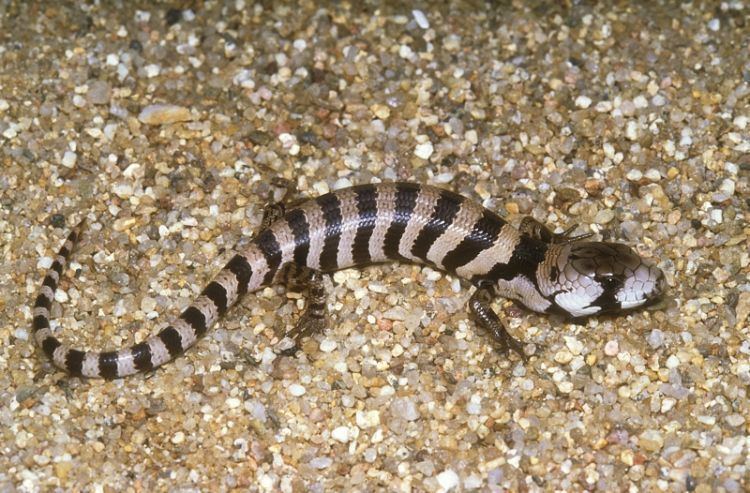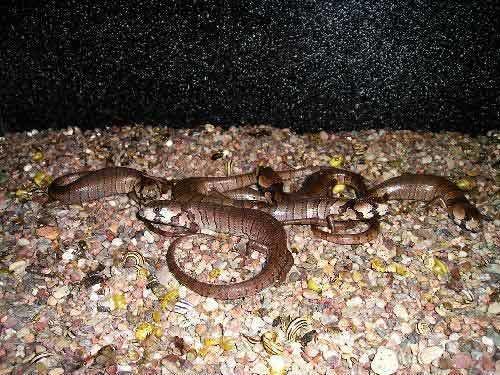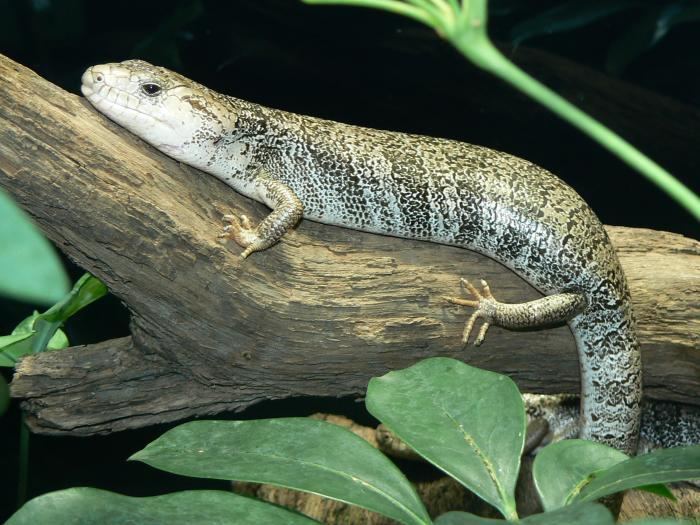Kingdom Animalia Suborder Sauria Family Scincidae Scientific name Hemisphaeriodon Phylum Chordata Order Scaled reptiles | Subphylum Vertebrata Infraorder Scincomorpha Subfamily Egerniinae Higher classification Skink Rank Genus | |
 | ||
Similar Skink, Cyclodomorphus, Reptile, Egernia, Eulamprus | ||
Hemisphaeriodon spring
Hemisphaeriodon is a genus of lizards containing only one species, Hemisphaeriodon gerrardii, the pink-tongued skink. The genus Hemisphaeriodon is closely related to the genus Cyclodomorphus, which contains some of the largest members of the skink family (Scincidae). In Australia H. gerrardii is called commonly the pink-tongued lizard. As suggested by these common names, its distinguishing characteristic is a pink tongue as opposed to the blue tongue of the closely related genus Tiliqua.
Contents
- Hemisphaeriodon spring
- Pink tongued skinks hemisphaeriodon gerrardii
- Eymology
- Description
- Range
- Ecology and behaviour
- Breeding biology
- References

Pink tongued skinks hemisphaeriodon gerrardii
Eymology

The specific name, gerrardii, is in honor of British herpetologist Edward Gerrard (1810-1910), who was Gray's "right-hand man" at the British Museum.
Description

Commonly known as a "pink-tongued skink", it is a relatively large lizard of up to 45 cm that has a slender body with a long, slender and slightly prehensile tail about the same length as the body. The limbs are well developed with long digits and sharp claws. The neck is well pronounced and the head is relatively large, wider in males than in females. In adults the tongue is pink. H. gerrardii has a slate-grey to fawn dorsal ground colour with dark grey to brown or black cross bands. These bands are more pronounced in males and less so in females. There are about 20 cross bands from the neck to the tip of the tail, which run slightly backwards laterally. The ventral surfaces of H. gerrardii are white to pinkish or creamy brown and may be marbled on the cross bands. The scales are smooth and, on the head, edged with a darker colour. The tip of the snout is dark in adults with some darker spots on the head. The limbs are spotted or streaked darkly. All juveniles are marked with pronounced black cross bands on a very light grey ground colour. There are several dark spots on their heads, especially under the eyes. The tip of the snout is light in colour and the tongue and mouth are blue. Similar species (Cogger 2000): H. gerrardii has been associated with the genus Tiliqua as well as the genus Cyclodomorphus due to their close relation (previous names: Cyclodomorphus gerrardii and Tiliqua gerrardii). H. gerrardii is very similar in appearance to the Eastern blue-tongue, Tiliqua scincoides; however, H. gerrardii has, true to its common name, a pink tongue as an adult. It is also much more slender than the T. scincoides, having a more slender body, a much longer and narrower tail as well as a smaller head. In addition, the limbs are more developed and longer than those of the blue-tongues. Hemisphaeriodon gerrardii can be distinguished from Cyclodomorphus spp.. by its relatively shorter body, longer limbs and a much broader head.
Range
From Springwood, NSW, along the eastern coastal country and eastern ranges to the Cairns region, QLD
Ecology and behaviour

Hemisphaeriodon gerrardii inhabit wet sclerophyll forests and rainforests as well as moist areas in woodlands. They shelter beneath leaf litter, in hollow logs and crevices of rocks and trees and their slender bodies and limbs are an adaptation for moving in thick undergrowth. Hemisphaeriodon gerrardii move with lateral undulations on smooth surfaces, but hold their hind limbs close to the body and move the tail in a side-winding motion when moving through grass and when climbing on branches, using only the forelimbs. The lizards’ main diet consists of snails and slugs, for which they forage during twilight hours and at night in summer and also during the day in cooler months. To crush the shells of snails, H. gerrardii use their large and flattened teeth in the back of the upper and lower jaw. Hemisphaeriodon gerrardii are good climbers using their semi-prehensile tail as a supporting aid and, although only partially arboreal, climb trees to feed when necessary. The juveniles seem to climb vegetation more frequently to avoid predation. When threatened, H. gerrardii raises its body off the ground to appear larger and flickers or vibrates its tongue rapidly similar to snakes.
Breeding biology

Courtship occurs in early spring for a period of six weeks, during which time males have been observed to fight. In mating, the male grasps the female’s head with his jaws and mounts her. After an estimated gestation period of 101 to 110 days, females produce large litters of 20 to 30 (largest recorded: 67) live-young in early summer. During birth, the female holds her hind legs close to her body, as when moving through grass, giving single births about every 30 minutes during which she moves around. The young are born curled up in a foetal membrane, which they eat after breaking free. Immediately after birth, the young start flickering their tongues. The tongue and mouth are dark blue and the ventral surface is black in juveniles, changing to pink and mauve respectively after about three months. The young are independent from straight after birth without any parental care and start feeding on slugs and snails. Age at sexual maturity is about 22 months.

